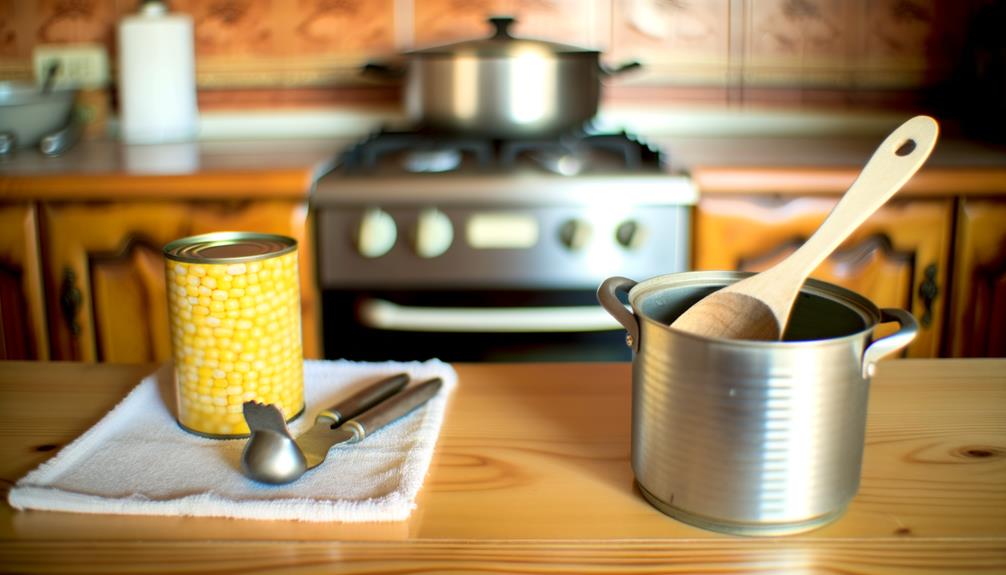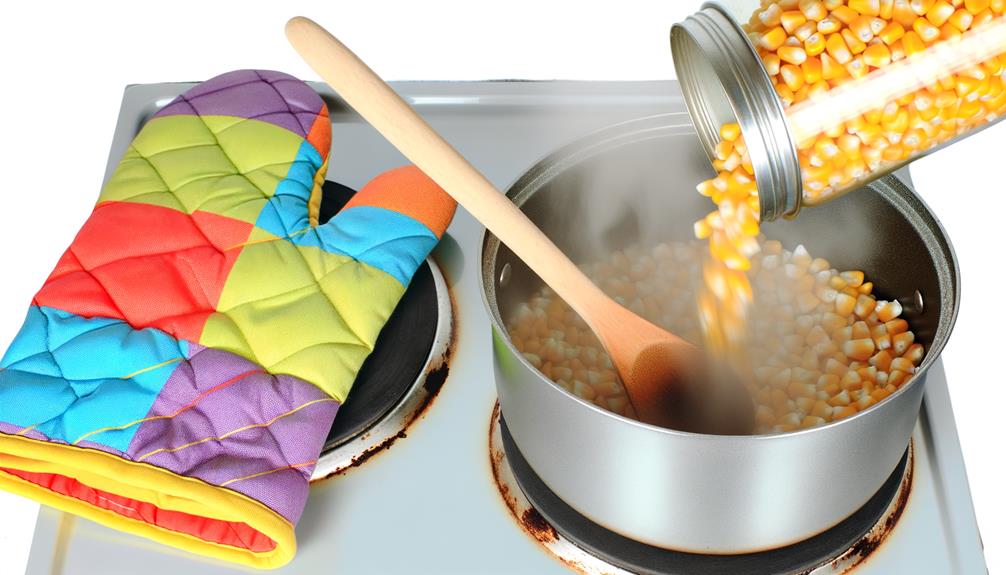Here's an easy way to cook canned corn. Drain the liquid from the can, then put the corn in a skillet, adding a bit of water to prevent sticking. A spoonful of butter is the secret – it enhances the flavor marvelously. Warm it over medium heat for about five minutes, stirring occasionally. Crave some extra kick? Don't hold back on seasoning. Garlic powder, maybe? The microwave works, too. Empty the can into a microwave-safe bowl, add a splash of water, butter, season, and zap it for a couple of minutes! Come on, let's unravel more culinary adventures with canned corn next.
Canned Corn's Origin Story
In the bustling era of the late 19th century, canned corn emerged as a groundbreaking way to preserve and enjoy corn throughout the year. The convenience of canned corn quickly made it a household staple. It could be stored for long periods, thanks to its extended shelf life, making it a vital food source, especially during the leaner months.
The process of canning corn was simple yet effective. It began with harvesting ripe corn, which was then shucked to remove the outer husk. The corn kernels were blanched to halt enzymes that could spoil the taste and texture. Finally, the corn was sealed into cans, trapping the freshness inside.
Canned corn's convenience extended beyond preservation. Its versatility allowed it to be used in a variety of recipes, from salads to casseroles, providing a sweet, delicious flavor and a hearty texture.
During World War II, canned corn's popularity soared. Its easy storage and long shelf life made it an essential part of the wartime diet. Today, I often turn to canned corn for quick and easy meals. It's a proof of the ingenuity of our ancestors, who mastered the art of preserving the bountiful harvest for future enjoyment.
Typical Canned Corn Components
When you open a can of corn, you'll typically find sweet corn kernels, water, salt, and occasionally corn starch. This basic composition makes canned corn a versatile ingredient in my kitchen. I often use it in salads, soups, and casseroles, or simply as a side dish.
One of the things I love about cooking canned corn is the flexibility it offers. I can heat it on the stovetop, or if I'm in a hurry, pop it in the microwave. Adding butter during the cooking process gives the corn a rich, smooth taste that's hard to resist. Seasonings, too, play a big role in elevating the flavor. A dash of salt, a sprinkle of pepper, maybe a pinch of garlic powder or even a smidgen of sugar – the choice is yours.
Here's a table summarizing the typical components and their roles:
| Component | Role | Added During Cooking |
|---|---|---|
| Corn Kernels | Main Ingredient | No |
| Water | Preserves Freshness | No |
| Salt/Corn Starch | Enhances Flavor/Texture | No |
| Butter | Adds Richness | Yes |
| Seasonings | Customizes Taste | Yes |
Canned Corn Preparation Method

Let's explore how to prepare canned corn, whether you're using the stove or the microwave. This pantry staple is easy to cook and versatile, offering a quick side dish or a hearty addition to your meals.
To cook canned corn on the stove, drain the corn and put it in a skillet. Add a small amount of water. Next, add some butter for a little richness and stir until the butter melts and the corn is heated through. Finally, season to taste.
You can also cook canned corn in the microwave. Rinse the corn, put it in a microwave-safe bowl, and add water and a dollop of butter. Cover with a microwave-safe lid or plate, and heat for about 2 minutes. Remember to stir halfway through. Once heated, drain the water and season as desired.
Here are some seasoning options to enhance your canned corn:
- Salt and sugar for a sweet-salty balance.
- Garlic or onion powder for a savory kick.
- Herbs like parsley or dill for a fresh twist.
- Spices like chili or paprika for a bit of heat.
Enjoy your perfectly cooked canned corn!
Expert Tips
Now, let's talk about some expert tips that can help you take your canned corn to the next level.
We'll discuss how you can enhance the corn's flavor, the best cooking methods to use, and some useful tips for serving and storage.
I'm sure you'll find these tips helpful and easy to follow.
Enhancing Corns Flavor
To give your canned corn a flavor boost, try adding a dash of spice like jalapeño or red pepper flakes. This will enhance the natural sweetness of the golden sweet corn.
If you're aiming for a creamier texture, add a dollop of cream cheese. It blends well with the corn and adds a rich, decadent touch.
A sprinkle of garlic powder can also enhance the overall flavor, lending a savory note that complements the sweet corn. Don't forget to season with salt and pepper for a balanced flavor.
Choosing Cooking Methods
Depending on your time and taste preferences, you can either microwave the drained canned corn with butter for a quick 1 min 30 sec meal, or simmer it on the stovetop with butter, milk, and salt for a richer flavor.
I often make small adjustments to enhance the natural sweetness of the corn. Add butter to the corn after it's drained and heat on medium high. Stir the corn and watch for it to start bubbling. Then, turn the heat down and add milk to give it a creamy texture. Remember, don't over-stir or the corn can become tough.
Trying different varieties like sweet or extra sweet corn can also shake things up a bit.
Serving and Storage Tips
Once you've cooked your canned corn, it's important to remember that any leftovers can be safely kept in the fridge for up to 3 days.
To make canned corn taste even better, add a tablespoon of butter to your corn kernels. This can transform it into a great side dish. You can also experiment with different seasonings to find the flavor you like best.
Canned vegetables like corn are super versatile, and you can easily reheat canned corn for a quick meal. If you've opened a can but didn't use all of it, make sure to refrigerate opened canned corn to keep it fresh.
Final Thoughts
In conclusion, it's clear that canned corn offers both convenience and versatility, with a variety of ways to cook and season it for enhanced flavor. You can heat canned Kernel Corn in a small saucepan on the stove or in the microwave. Add a tablespoon of butter or milk to improve its creamy texture. If you're seeking a healthier alternative, consider using frozen corn instead.
Feel free to experiment with different seasonings. From jalapeño to red pepper flakes, Parmesan, or even your preferred herbs, the options are limitless. Just remember to adjust the salt based on the sodium content in your canned corn.
Naturally, cooking is all about personal preferences. So go ahead, play around with your canned corn and create your own unique recipe. This site uses Akismet to assist us in understanding how your comment can influence our content. Place the corn in your preferred dish or savor it as a simple side.
